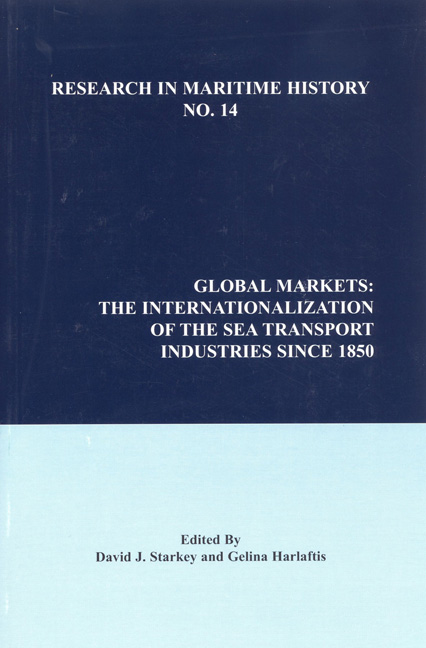Book contents
- Frontmatter
- Contents
- About the Editors
- Contributors
- Introduction
- “International Freight Markets in the 1830s and 1840s: The Experience of a Major Finnish Shipowner”
- “The First (and Very Secret) International Steamship Cartel, 1850-1856”
- “Competition or Co-operation in the Global Shipping Industry: The Origins and Impact of the Conference System for British Shipowners before 1914”
- “National Alliances and Global Webs: The Internationalization of Japanese Shipping”
- “Dutch Sea Transport in Transition: The German Hinterland as Catalyst, 1850-1914”
- “The Expansion of American Interests in Transatlantic Commerce and Trade, 1865-1893”
- “The Expansion of Japan's Shipping Interests before the Sino-Japanese War”
- “Cooperation and Reorganization on the North-South Routes from Japan in the Interwar Period”
- “The Global Communications Industry and Its Impact on International Shipping before 1914”
- “The Nineteenth-Century Roots of Globalization: Some Technological Considerations”
- “The Global Fish Market: Internationalization and Globalization, 1880-1997”
- “Convergence or National Styles? The Japanese Challenge to the British-Norwegian Hegemony in the Twentieth-Century Whaling Industry”
- “International Trends and Greek Shipping: The Business Strategy of Demetrios Moraitis, 1893-1908”
- “Organizational and Managerial Patterns of Greek- Owned Shipping Enterprises and the Internationalization Process from the Internar Period to 1990”
- “Internationalization and the Collapse of British Shipbuilding, 1945-1973”
- “Globalization and International Competitiveness: The Experience of the Japanese Shipping Industry since the 1960s”
- “Containerization and the Globalization of Liner Shipping“
“Containerization and the Globalization of Liner Shipping“
- Frontmatter
- Contents
- About the Editors
- Contributors
- Introduction
- “International Freight Markets in the 1830s and 1840s: The Experience of a Major Finnish Shipowner”
- “The First (and Very Secret) International Steamship Cartel, 1850-1856”
- “Competition or Co-operation in the Global Shipping Industry: The Origins and Impact of the Conference System for British Shipowners before 1914”
- “National Alliances and Global Webs: The Internationalization of Japanese Shipping”
- “Dutch Sea Transport in Transition: The German Hinterland as Catalyst, 1850-1914”
- “The Expansion of American Interests in Transatlantic Commerce and Trade, 1865-1893”
- “The Expansion of Japan's Shipping Interests before the Sino-Japanese War”
- “Cooperation and Reorganization on the North-South Routes from Japan in the Interwar Period”
- “The Global Communications Industry and Its Impact on International Shipping before 1914”
- “The Nineteenth-Century Roots of Globalization: Some Technological Considerations”
- “The Global Fish Market: Internationalization and Globalization, 1880-1997”
- “Convergence or National Styles? The Japanese Challenge to the British-Norwegian Hegemony in the Twentieth-Century Whaling Industry”
- “International Trends and Greek Shipping: The Business Strategy of Demetrios Moraitis, 1893-1908”
- “Organizational and Managerial Patterns of Greek- Owned Shipping Enterprises and the Internationalization Process from the Internar Period to 1990”
- “Internationalization and the Collapse of British Shipbuilding, 1945-1973”
- “Globalization and International Competitiveness: The Experience of the Japanese Shipping Industry since the 1960s”
- “Containerization and the Globalization of Liner Shipping“
Summary
“Getting that ‘third ocean’ is a goal every liner operator is pursuing right now, representing the great leap towards a global service.“
“[The future of our company resides in] ever larger ships and further company mergers or take-overs …. in order to service the increasing number of global customers.“
“Container shipping is a mature global service industry.“
The purpose of this chapter is to analyze the development of container shipping from the mid-1960s to the present day. As it would be patently impossible to cover the subject in a fully comprehensive fashion, the discussion will focus on the following pivotal questions: what have been the reasons for the introduction and the rapid diffusion of containerization in the world's liner shipping industry? what has been the impact of containerization on the structure of individual companies and the industry as a whole? and, how has containerization changed the relationship of shipowners with other modes of transport, the ports and port systems of the world, and the agencies that acquire their cargoes? Positioning these questions within the overall theme of “global markets,” I shall specifically argue that containerization has globalized both the liner shipping industry and the self-image and outlook of the major companies. This is meant not just in terms of the general internationalization of the post-1945 shipping industry in its ownership, investment capital, flags, seafarers, shipyards, cargoes, destinations, etc., but especially also in specific aspects of the liner industry, particularly global services and agency networks, intimate international cooperation and mergers, and functional diversification into port facilities and the related maritime and non-maritime modes of transport. Liner shipping always contained significant elements of both internationalization and functional integration, but containerization carried these tendencies onto an entirely higher level.
Revolution and Chain Reaction
Containerization resulted directly from the crisis that faced many of the world's major liner companies in the early 1960s. Liner shipping was increasingly suffering from the severe financial burdens placed on it by the current technological state of cargo-handling in port. The loading and discharging of large numbers of individual packages, boxes, bags, crates etc. of often bewildering varieties of shapes and sizes caused long turnround times in port and huge wastage in capital invested.
- Type
- Chapter
- Information
- Global MarketsThe Internationalization of The Sea Transport Industries Since 1850, pp. 385 - 424Publisher: Liverpool University PressPrint publication year: 1998



